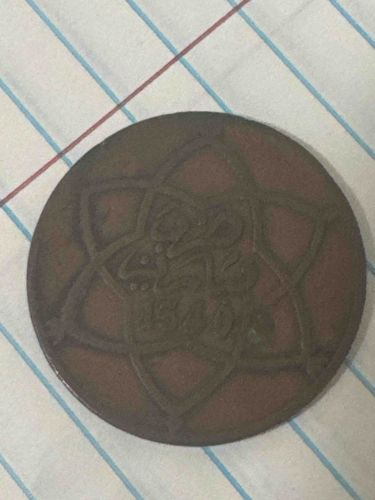
Ottoman Empire Coin, Possibly from the Reign of Mahmud II or Abdulmejid I (1340 AH)
This item is a circular, metallic coin, likely made of copper or a copper alloy, given its reddish-brown color and the typical numismatic compositions of the Ottoman era. The coin has a diameter that appears to be standard for Ottoman currency of its time, though exact measurements are not possible from the image. Its surface is heavily oxidized, showing a dark brown to reddish-brown patina that is consistent with age and exposure to the elements. The obverse features an intricate and ornate design, characteristic of Ottoman coinage. At its center, there is a clear inscription '1340', which is an Islamic calendar year (AH) and translates to approximately 1921-1922 in the Gregorian calendar. This date suggests the coin belongs to a later period of the Ottoman Empire, possibly the reign of Sultan Mehmed VI, but its stylistic elements with the central design are more indicative of earlier reigns like Mahmud II or Abdulmejid I, who used elaborate central motifs within star-like or floral patterns. The '1340' inscription could represent a regnal year plus date, a mint date, or a different numbering system depending on the precise type. Surrounding the central inscription and prominent tughra-like emblem are geometric or stylized floral patterns forming a star or rosette shape with multiple points, possibly six or eight, which is a common design element in Islamic art and coinage. The edges of the design are somewhat worn, and the overall relief is low to medium, although the details are still discernible despite the wear. There are no immediate signs of severe damage such as bends or deep scratches, but the surface exhibits a natural, aged texture with minor pitting that contributes to its historical character. The coin shows typical circulation wear on raised areas, indicating it was indeed used as currency. There are no visible maker's marks or specific minting locations discernible from this image. The quality of craftsmanship appears to be typical for mass-produced coinage of the period, demonstrating an effort in intricate design but also the practicalities of production.
AI-Generated Appraisal Disclaimer
Estimated Value
$50 - $100
Basic Information
Category
Coinage_Ottoman_Empire
Appraised On
November 12, 2025
Estimated Value
$50 - $100
Additional Details Provided By Owner
User Provided Information
1340 coin
Item Description
This item is a circular, metallic coin, likely made of copper or a copper alloy, given its reddish-brown color and the typical numismatic compositions of the Ottoman era. The coin has a diameter that appears to be standard for Ottoman currency of its time, though exact measurements are not possible from the image. Its surface is heavily oxidized, showing a dark brown to reddish-brown patina that is consistent with age and exposure to the elements. The obverse features an intricate and ornate design, characteristic of Ottoman coinage. At its center, there is a clear inscription '1340', which is an Islamic calendar year (AH) and translates to approximately 1921-1922 in the Gregorian calendar. This date suggests the coin belongs to a later period of the Ottoman Empire, possibly the reign of Sultan Mehmed VI, but its stylistic elements with the central design are more indicative of earlier reigns like Mahmud II or Abdulmejid I, who used elaborate central motifs within star-like or floral patterns. The '1340' inscription could represent a regnal year plus date, a mint date, or a different numbering system depending on the precise type. Surrounding the central inscription and prominent tughra-like emblem are geometric or stylized floral patterns forming a star or rosette shape with multiple points, possibly six or eight, which is a common design element in Islamic art and coinage. The edges of the design are somewhat worn, and the overall relief is low to medium, although the details are still discernible despite the wear. There are no immediate signs of severe damage such as bends or deep scratches, but the surface exhibits a natural, aged texture with minor pitting that contributes to its historical character. The coin shows typical circulation wear on raised areas, indicating it was indeed used as currency. There are no visible maker's marks or specific minting locations discernible from this image. The quality of craftsmanship appears to be typical for mass-produced coinage of the period, demonstrating an effort in intricate design but also the practicalities of production.
Get Your Items Appraised
Instant estimates of your treasures with AI-powered instant appraisals